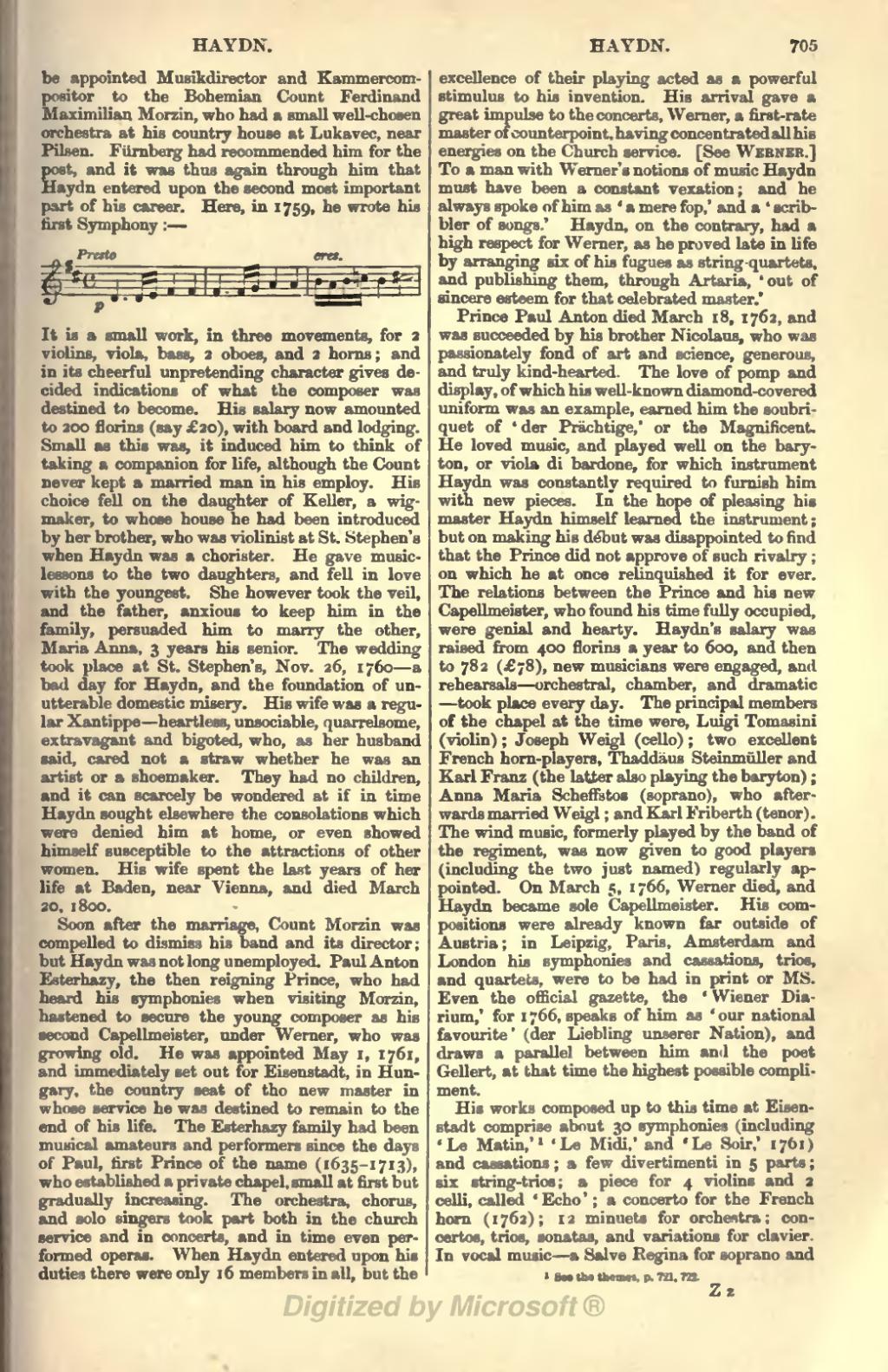be appointed Musikdirector and Kammercompositor to the Bohemian Count Ferdinand Maximilian Morzin, who had a small well-chosen orchestra at his country house at Lukavec, near Pilsen. Fürnberg had recommended him for the post, and it was thus again through him that Haydn entered upon the second most important part of his career. Here, in 1759, he wrote his first Symphony:—

It is a small work, in three movements, for 2 violins, viola, bass, 2 oboes, and 2 horns; and in its cheerful unpretending character gives decided indications of what the composer was destined to become. His salary now amounted to 200 florins (say £20), with board and lodging. Small as this was, it induced him to think of taking a companion for life, although the Count never kept a married man in his employ. His choice fell on the daughter of Keller, a wigmaker, to whose house he had been introduced by her brother, who was violinist at St. Stephen's when Haydn was a chorister. He gave music-lessons to the two daughters, and fell in love with the youngest. She however took the veil, and the father, anxious to keep him in the family, persuaded him to marry the other, Maria Anna, 3 years his senior. The wedding took place at St. Stephen's, Nov. 26, 1760—a bad day for Haydn, and the foundation of unutterable domestic misery. His wife was a regular Xantippe—heartless, unsociable, quarrelsome, extravagant and bigoted, who, as her husband said, cared not a straw whether he was an artist or a shoemaker. They had no children, and it can scarcely be wondered at if in time Haydn sought elsewhere the consolations which were denied him at home, or even showed himself susceptible to the attractions of other women. His wife spent the last years of her life at Baden, near Vienna, and died March 20, 1800.
Soon after the marriage, Count Morzin was compelled to dismiss his band and its director; but Haydn was not long unemployed. Paul Anton Esterhazy, the then reigning Prince, who had heard his symphonies when visiting Morzin, hastened to secure the young composer as his second Capellmeister, under Werner, who was growing old. He was appointed May 1, 1761, and immediately set out for Eisenstadt, in Hungary, the country seat of the new master in whose service he was destined to remain to the end of his life. The Esterhazy family had been musical amateurs and performers since the days of Paul, first Prince of the name (1635–1713), who established a private chapel, small at first but gradually increasing. The orchestra, chorus, and solo singers took part both in the church service and in concerts, and in time even performed operas. When Haydn entered upon his duties there were only 16 members in all, but the excellence of their playing acted as a powerful stimulus to his invention. His arrival gave a great impulse to the concerts, Werner, a first-rate master of counterpoint, having concentrated all his energies on the Church service. [See Werner.] [App. p.670 omits this reference] To a man with Werner's notions of music Haydn must have been a constant vexation; and he always spoke of him as 'a mere fop,' and a 'scribbler of songs.' Haydn, on the contrary, had a high respect for Werner, as he proved late in life by arranging six of his fugues as string-quartets, and publishing them, through Artaria, 'out of sincere esteem for that celebrated master.'
Prince Paul Anton died March 18, 1762, and was succeeded by his brother Nicolaus, who was passionately fond of art and science, generous, and truly kind-hearted. The love of pomp and display, of which his well-known diamond-covered uniform was an example, earned him the soubriquet of 'der Prächtige,' or the Magnificent. He loved music, and played well on the baryton, or viola di bardone, for which instrument Haydn was constantly required to furnish him with new pieces. In the hope of pleasing his master Haydn himself learned the instrument; but on making his début was disappointed to find that the Prince did not approve of such rivalry; on which he at once relinquished it for ever. The relations between the Prince and his new Capellmeister, who found his time fully occupied, were genial and hearty. Haydn's salary was raised from 400 florins a year to 600, and then to 782 (£78), new musicians were engaged, and rehearsals—orchestral, chamber, and dramatic—took place every day. The principal members of the chapel at the time were, Luigi Tomasini (violin); Joseph Weigl (cello); two excellent French horn-players, Thaddaus Steinmuller and Karl Franz (the latter also playing the baryton); Anna Maria Scheffstos (soprano), who afterwards married Weigl; and Karl Friberth (tenor). The wind music, formerly played by the band of the regiment, was now given to good players (including the two just named) regularly appointed. On March 5, 1766, Werner died, and Haydn became sole Capellmeister. His compositions were already known far outside of Austria; in Leipzig, Paris, Amsterdam and London his symphonies and cassations, trios, and quartets, were to be had in print or MS. Even the official gazette, the 'Wiener Diarium,' for 1766, speaks of him as 'our national favourite' (der Liebling unserer Nation), and draws a parallel between him and the poet Gellert, at that time the highest possible compliment.
His works composed up to this time at Eisenstadt comprise about 30 symphonies (including 'Le Matin,'[1] 'Le Midi,' and 'Le Soir,' 1761) and cassations; a few divertimenti in 5 parts; six string-trios; a piece for 4 violins and 2 celli, called 'Echo'; a concerto for the French horn (1762); 12 minuets for orchestra; concertos, trios, sonatas, and variations for clavier. In vocal music—a Salve Regina for soprano and
- ↑ See the themes, p. 721, 722.
